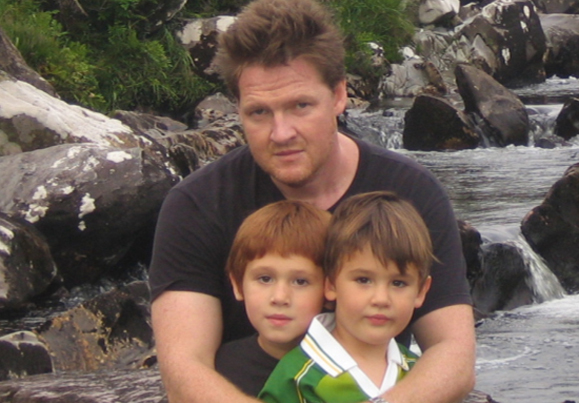Red hair and pale skin can be very attractive to some, but the potential perils from the sun range from mere sunburn to possibly fatal cancer, as actor Donal Logue discovered.
I am a redhead. Yes, I know we’re called “gingers” these days, but when I was growing up this was a term I only heard when visiting my equally pale, redheaded relatives back in Ireland or the UK, so I’ll stick with redhead. Which is what I am. Or was. Over time my hair has darkened, my beard has whitened, and many of the freckles on my face and shoulders have morphed into a morass of blues, pinks and greens floating on the fish-belly white sea of my skin.
Unlike my pale Irish relatives, however, I grew up in the desert on the Mexican border, just a hop, skip and a jump south from where the highest temperature on this sun-splashed sphere was ever recorded. You can see where this is going. I spent the seventies like a lot of Californian desert youth, playing baseball and soccer, running, skateboarding, and generally baking outside in the sun all day, back when baby oil was my generation’s “sunscreen” of choice.
So it was really no surprise when this past summer, while back in Ireland, where I was spending many hours a day outdoors, shooting a TV show under the sunniest skies the Emerald Isle – thanks to global warming – had seen in decades, I noticed that the bump of reddish/flaky skin on my scalp-line was acting up again.
Some years back I had off-handedly mentioned this abnormal patch, one of dozens I have on my body, to a dermatologist in LA. He was sufficiently concerned to have subsequently frozen it off with liquid nitrogen. That seemed to do the trick until this past summer, when it suddenly, like a tiny Dionysus revived by the wild, Irish sun, came back from the dead.
This time I was concerned enough that I actually paid a visit to a doctor in Ireland, who glanced at it and said, “Ah sure, ye’re grand. ’Tis nothing.” But when the shoot was finished, and I was finally back in the States, I mentioned it to my best friend Gilles. He immediately dragged me to Dr. Gene Rubenstein, an awesome dermatologist whom I knew from my son’s school.
A sample was cut out of my noggin for biopsy, and then, not thinking I would ever have to deal with whatever it might or might not be in any immediate sense, I drove 12 hours north to my home in Oregon.
Two days later, Gilles called me from LA, and said, in his fairly unintelligible French accent, “You have to call the doctor!”
“Calm down,” I said. “He has my number.”
“Call him now,” he snapped.
When I finally spoke to Dr. Rubenstein, he told me I had squamous cell carcinoma and that I had to schedule a surgery. I told him I had to go to Canada to shoot a film in a week and asked if I could go under the knife in March.
“No,” he said. “You’re doing it tomorrow morning.” He assured me that though squamous cell carcinoma is usually treatable, this one gravely concerned him because it had apparently traveled lower into my scalp through some hair follicles. He was worried about how long it had been active in the subcutaneous part of my forehead: the danger zone.
I immediately turned around and drove the 12 hours back to LA, completely calm. I remained so even after the initial hole cut into my head was deemed insufficiently large enough to get rid of all the cancer. A second bout of cutting ensued, and now I realized I had a pretty significant crater in my head.
“No problem,” the doc said. “We’ll sew it shut. It’ll smooth out your forehead.” Good lord, I thought: an accidental facelift.
I recently had my stitches pulled and the doc gave me a good prognosis but also a stern warning: “You are at very high risk to have more squamous, so no sun and a hat and sunscreen at all times!”
This was, suffice it to say, a wake-up call. Now that I’ve had skin cancer, I know I have to be extra vigilant in the future: to check for new spots, to stay out of the sun if I can, to wear sunscreen when I can’t. Today, when I check my face in the mirror for new growths, I wish I could shake that young boy I once was, running around under the hot, desert sun without protection, for doing such ineradicable damage to his future skin.
On the other hand, my 14-year-old son did say to me, when he saw my 47-year-old visage after the stitches were pulled out, “Dad, it’s like your face is 75, but your forehead is 25.” So there’s that. ♦
Award-winning actor Donal Logue appeared most recently in Copper, Sons of Anarchy, and Vikings. He also will star as Detective Harvey Bullock in Fox’s new Batman prequel TV series, Gotham. He is also a trucker and now novelist, whose first novel, AGUA, will be released by Harper Collins later this year. He joins Everyday Health–and skin cancer survivors everywhere–in urging you to please get any unusual-looking spots on your skin checked out by a doctor.
This article first appeared on everydayhealth.com.
Dr. Thomas B. Fitzpatrick developed the Fitzpatrick Scale in 1975, a numerical classification of skin color and how UV rays affect skin tones. The Fitzpatrick Scale is still used today, contributor Adam Farley shares more information on the Fitzpatrick Scale and the risk factors we should all be aware of in Fact Sheet: Skin Cancer.


We should be aware of the important points in this article about what you should know on skin cancer. This would really mean a lot. Thanks for sharing this one out.